Learn how to make a quick bread classic with this homemade beer bread recipe. Using just 6 ingredients and one mixing bowl, this rustic loaf is easy to make for game day or a cozy snack.
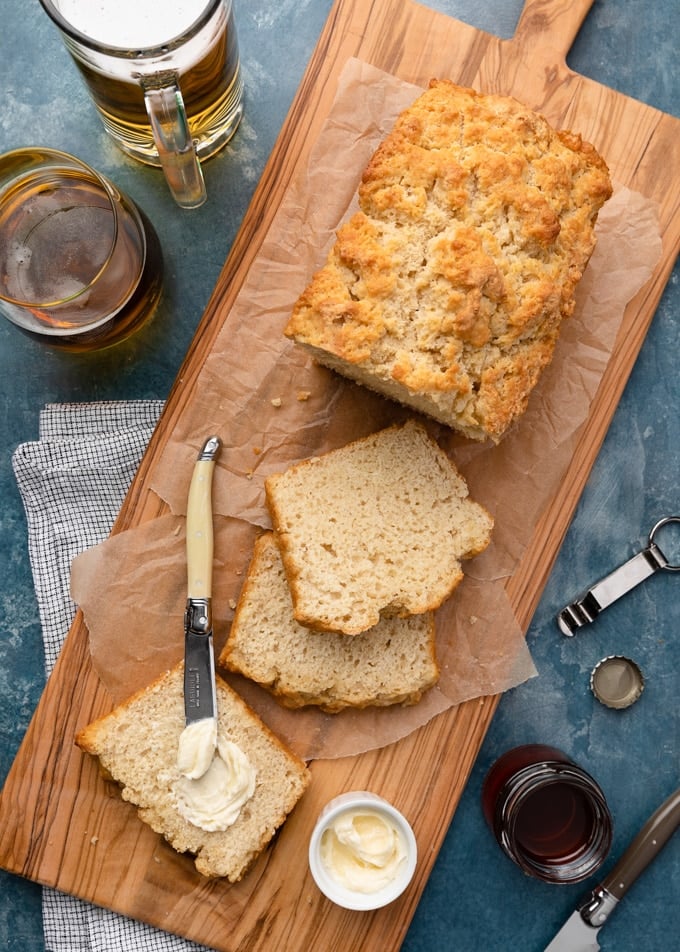
Back in college (more years ago than I care to admit!), one of the first breads I made in my tiny apartment kitchen was Beer Bread. It was an easy recipe that didn’t require proofing or kneading, and my friends always devoured it.
With its lightly-sweet flavor and buttery, craggy crust, beer bread is a classic loaf. I keep the recipe in my back pocket for when I need a fuss-free and delicious bread for snacking or casual entertaining.
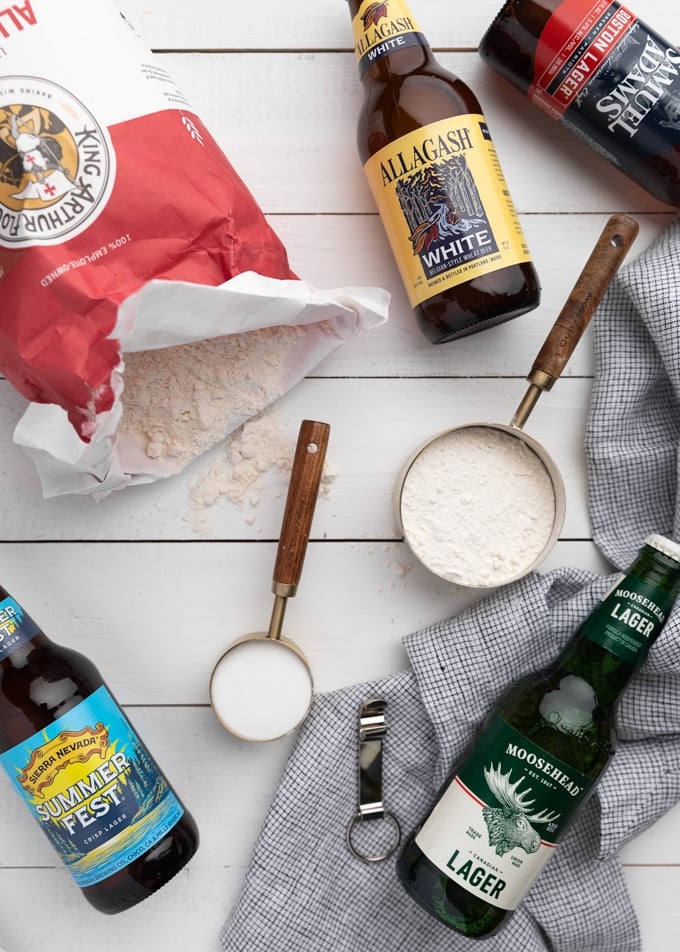
What You’ll Need From the Pantry
With only 6 ingredients, Beer Bread is one of the simplest breads you can make. You’ll need all-purpose flour, baking powder, table salt, sugar, beer, and melted butter. That’s it!
What Kind of Beer Is Best for Beer Bread?
The type of beer you use is entirely up to your personal preferences and how much you want to taste it in the baked loaf. My friends and I prefer lighter-tasting, crisp, lager-style beers and Belgian-style witbiers in bread.
I find that more strongly-flavored beers, or those that are very hops-forward, can overpower the loaf when baked. In some cases, they can also make the bread taste too bitter. With that in mind, I tend to stay away from brews like IPA’s and strong stouts for this recipe.
Want to learn more about bitterness in beer? This article from Craft Beer Joe, Hoppy vs. Bitter: Understanding the Difference, is an interesting read!
I’ve made beer bread with everything from craft beers (Allagash White, Moosehead, etc.), to commercial beers like Heineken, Miller Highlife, and Samuel Adams Boston Lager (which we found lends more of a pronounced aroma than others on the list, and didn’t make our favorite loaf).
For the mildest beer flavor in your bread, use a light beer, such as Miller’s Lite, Coors Light, or Bud Light.
For a twist from the classic, you can also make this beer bread recipe using seasonal brews. We have fun in the fall making loaves with pumpkin ale and hard cider.
Really, the best way to determine the beer you like best for your beer bread is to jump in and try a loaf with your favorite bottle! If the flavor is too strong, bitter, or fruity, you’ll know that you need to move to a different brew.
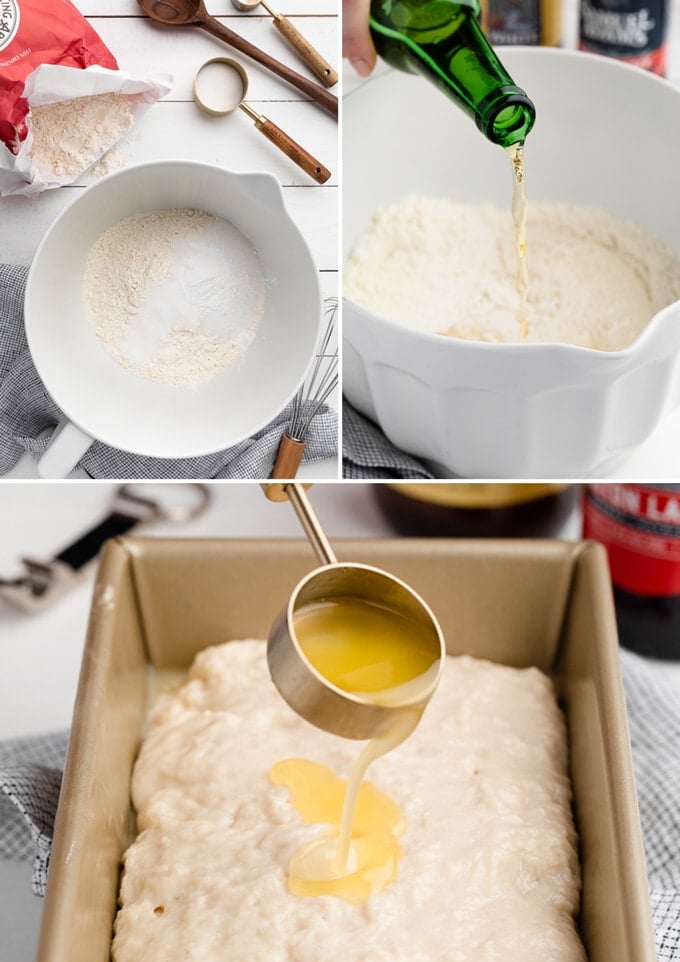
Tips for Making The Best Beer Bread
Making beer bread is about as easy as it gets: 1.) whisk together the dry ingredients, 2.) mix in the beer, 3.) pour melted butter over the batter in a loaf pan, and 4.) bake.
While beer bread has a dense and chewy crumb by nature, I’ve had loaves that sadly turned out too tough. Over the years, I’ve found that a few tips will ensure the best textured (and best tasting) loaf.
- Sift the flour. I always use a “spoon and sweep” method for measuring my flour (i.e. spoon the flour into the measuring cup and sweep the top with the straight edge of a butter knife). For beer bread, I find that sifting the flour before measuring it out creates the best crumb.
- Use room temperature beer. It will give you a better rise and baked texture than a bottle straight out of the fridge.
- Don’t over-mix the dough. When you add the beer, you want to just mix it in enough so the dry ingredients are moistened and everything is incorporated. (This usually takes about 5 or 6 turns in the bowl with my wooden spoon or spatula.) A few dry streaks are okay. Overworking the dough will yield a too-dense loaf.
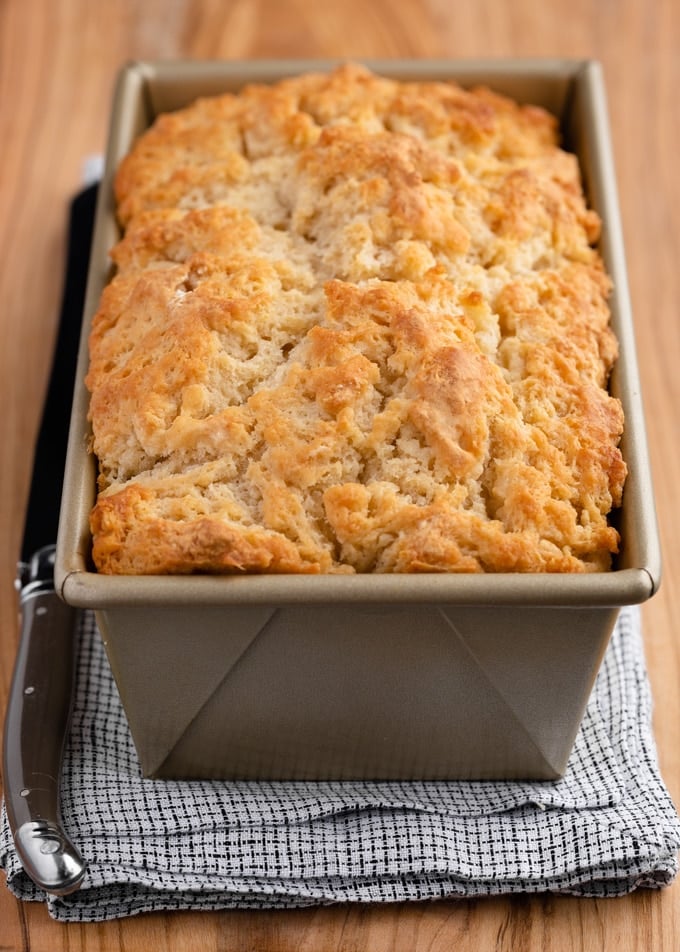
Common Questions About Beer Bread
Q. Can I use other sweeteners instead of granulated sugar?
A. Sure! I’ve made this loaf with light brown sugar, honey, and maple syrup (especially delicious with a pumpkin ale during the fall).
Just as with the granulated sugar, add anywhere from 1 to 4 tablespoons of any of these natural sweeteners, to your personal preferences.
Q. Why do you specify a range for the sweetener quantities?
A. So you can customize the loaf! You can make beer bread with just a hint of sweetness or more, depending on the flavor you like best and how you’re going to serve it.
For instance, you might want to make the bread a little less sweet to serve with a soup or stew than if you were going to have the slices on their own, as a snack.
The amount of sweetener can also depend on the type of beer you’re using. Some beers (or hard ciders) have more of a natural sweetness to them that will need less added sugar in the bread.
Q. I see a lot of recipes that call for self-rising flour. Can I use it here?
A. Yes. I don’t typically keep self-rising flour in my pantry, so I wrote the recipe using all-purpose flour, baking powder, and salt. To substitute self-rising flour, omit the baking powder and salt.
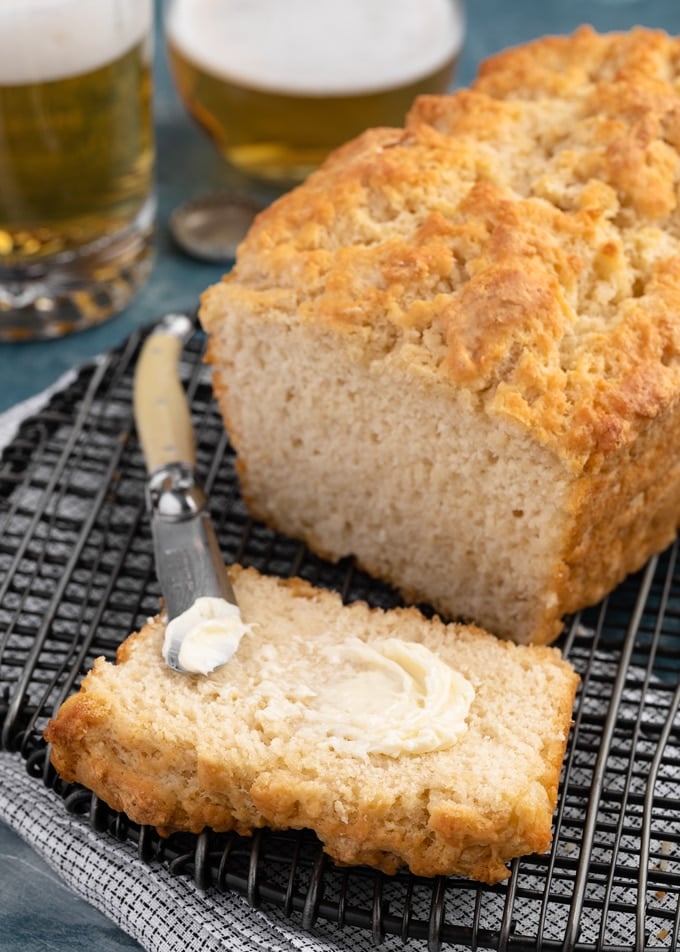
Serving and Storing Beer Bread
I like to serve beer bread just slightly warm with a smidge of softened or whipped butter (usually salted). When I’m going for a sweet treat, I’ll add a drizzle of honey, or use honey or maple butter.
Savory beer bread is great with chili on game day (we love it alongside my Instant Pot Texas-Style Chili), a hearty bowl of soup, cut into cubes to serve with dips, or just on it’s own for an easy, home-baked snack.
I do find that beer bread is best the day it’s made. It can get a little heavy on day 2 and beyond.
That said, if you’re going to store leftovers, wrap the loaf tightly in plastic wrap (make sure they’re cooled fully) and store at room temperature to enjoy on a second day. For the best texture and flavor, I like to re-warm the loaf in the oven at 350 degrees F, wrapped in foil.
My friends and I haven’t liked the texture of beer bread that had been frozen. This is a recipe that we prefer to make and serve it fresh.
CRAVING MORE? Subscribe to my newsletter and join me on Facebook, Pinterest, and Instagram for the latest recipes and news.

Classic Beer Bread
Ingredients
- 3 cups sifted all-purpose flour (I use King Arthur) , 350 grams (measured with the spoon-and-level method after sifting)
- 1 tablespoon baking powder , (12 grams)
- 1 teaspoon table salt , (6 grams)
- 2 to 4 tablespoons granulated sugar , (25-50 grams), depending on how sweet you like your bread
- 12 ounce bottle of beer , room temperature
- 2 tablespoons butter , melted (28 grams), plus additional for greasing the loaf pan
Instructions
- Preheat oven to 375 degrees F. Butter a 1 pound (8 1/2" x 4 1/2" x 2 3/4" high) loaf pan.
- In a large bowl, whisk together flour, baking powder, salt, and sugar. Pour in beer and stir just to combine. For a tender bread, don't over-mix. Batter will be thick and won't have a totally smooth appearance.
- Spoon batter into the prepared loaf pan and spread it out so it reaches all four corners. Drizzle with the melted butter.
- Bake for 35-55 minutes, until the top is golden and a cake tester inserted into the center of the loaf comes out with just a few moist crumbs attached. (Baking time will depend on the heat conductivity of the pan you're using, as well as your oven; my loaves most often take 40-45 mintues.)
- Let the bread cool in the pan for 5 minutes before inverting onto a wire rack. Slice the bread when it's just slightly warm or room temperature and serve.
Video
Notes
Nutrition Estimate
Nutrition information is automatically calculated, so should only be used as an approximation.
About our recipes
Please note that our recipes have been developed using the US Customary measurement system and have not been tested for high altitude/elevation cooking and baking.
















it was a hit at potluck recently so made it again…yummy and easy
I’ve made this bread for years. so easy and goes so well with soup and chili.
I butter and toast in a skillet. It is so good with homemade jam.
Do you think this would taste OK without sugar? I made it with the recommended amount and I thought it tasted way too sweet although I am sensitive to sugar.
My family finds that omitting sugar from this recipe results in a loaf that’s a bit bland and one-note in terms of the beer flavor. That said, if you are sensitive to sugar, you might enjoy the flavor of an unsweetened loaf. You could also try reducing the sugar to 1 tablespoon.
May I ask what beer you used? 2 tablespoons of sugar to 3 cups of flour should’ve only imparted a mild sweetness to the bread, unless the beer itself was on the sweeter side.